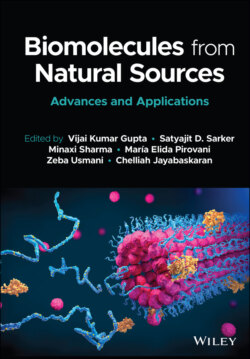Читать книгу Biomolecules from Natural Sources - Группа авторов - Страница 23
1.4.1 Microorganisms
ОглавлениеTrehalose lipids are made up of a disaccharide, trehalose, linked by an ester bond to a-branched b-hydroxy fatty acids (Lang and Philp 1998). The a-branched b-hydroxy fatty acids are connected at the C6 and C60 of the carbohydrate structure in the case of the trehalose dimycolates and at C6 for the monomycolates; other structure types have also been reported (Lang and Philp 1998). The production of trehalose lipids is associated with most species of Mycobacterium, Rhodococcus and Corynebacterium.
Trehalose lipids are usually produced by Gram-positive bacteria. Many studies display use of a different microorganisms, such as Arthrobacter, Rhodococcus, Gordonia (Lang and Philp 1998), Mycobacterium, Nocardia and Corynebacterium, which allowed trehalose lipids which differ in structure, size, degree of saturation and mycolate group (Franzetti et al. 2010).
Nevertheless, some of the producing bacteria are pathogenic mycobacteria (including pathogens in the Mycobacterium avium, M. intracellulare group, nocardia (Nocardia asteroids), and corynebacteria (Corynebacterium diphtheria, C. matruchotii, and C. xerosis) and the observed or potential pathogenicity of these producer strains, as well as the high toxicity of the biosynthesized glycolipids, significantly restricted their use, specifically in the biomedical field, in which is mandatory they are GRAS (Generally Regarded As Safe). For this purpose, non-pathogenic producing bacteria have been studied, in particular, representatives of Rhodococcus, Gordonia, Dietzia, Tsukamurella, Skermania, Williamsia, among others (Kuyukina and Ivshina 2019; Kuyukina et al. 2020). Although all of these microorganisms can be used for the production of trehalose lipids, Nocardia and Rhodococcus are the most widely explored (Patil and Pratap 2018).
In the case of Rhodococcus and related genera, the trehalose lipids biosynthesized are usually bound to the cell envelope and are produced mainly when the microorganisms are grown on hydrocarbon sources. This ability to access hydrocarbons is related to the microorganism’s cell surface hydrophobicity. Cells with high hydrophobicity directly contact oil drops and solid hydrocarbons, while low hydrophobicity allows the adhesion of microbial cells to the micelles or emulsified oils, formed due to the presence of extracellular biosurfactants (Franzetti et al. 2010). White et al. (2013) evaluated the production of trehalose lipids by a marine bacterium Rhodococcus sp. PML026 using sunflower oil as a hydrophobic substrate.
The capacity to produce a metabolite is bestowed by the genes of the microrganism, affecting the yield of biotechnological products. A production process is commercially viable and profitable after the yield of the final product by the producer organisms is high, in fact the bioindustrial production process is often dependent on the use of hyperproducing microbial strains, even with cheap raw materials, optimized medium and culture conditions, and efficient recovery processes (Bouassida et al. 2018). The genetic manipulation to improve production of biosurfactants was highlighted in 2016 by Paulino et al. (2016).
Moreover, when good yields from natural producer strains are lacking, the industrial production process will depend on the availability of recombinant and mutant organisms. To economize the production process further and to obtain products with better commercially important properties, recombinant hyperproducers have been developed. However, only a few mutant and recombinant varieties with enhanced biosurfactant production characteristics are reported in the literature (Mukherjee et al. 2006). Transposons (Koch et al. 1991), chemical mutagens (e.g., N-methyl-N0 nitro-Nnitrosoguanidine (Lin et al. 1998), radiation (Iqbal et al. 1995) or by selection are strategies used to produce mutant varieties.
The first report about the use of genetic engineering was the insertion and expression of the Vitreoscilla hemoglobin gene (vgb) in Gordonia amarae. This resulted in enhancement of trehalose lipid production in a medium supplemented with 1% hexadecane (Dogan et al. 2006). The elucidation of biosynthetic pathways through the identification of putative acyl coenzyme A transferase, fructose-biphosphate aldolase, and alkane monooxygenase genes and genetic manipulation allowed an increase in succinoyl trehalolipid production by Rhodococcus sp. strain SD-74 (Inaba et al. 2013).
The screening of biosurfactant producers can be carried out using several methods (qualitative and/or quantitative) with variable precisions and aims. Some examples of these methods are the following: (i) hemolytic assay (HA) (Carrillo et al. 1996), (ii) the N-Cetyl-N,N,N-trimethylammoniumn bromide (CTAB) agar plate method (Pinzon and Ju 2009), (iii) cell surface hydrophobicity methods, that is to say bacterial adherence to hydrocarbons (BATH) assay (Desai and Banat 1997) and microbial adherence to hydrocarbons (MATH) assay (Siegmund and Wagner 1991), (iv) the oil spreading method (Morikawa et al. 2000), (v) emulsification activity (Varjani et al. 2014), (vi) tilted glass slide (Satpute et al. 2010), (vii) hydrocarbon overlay agar (HOA) (Satpute et al. 2008), (viii) aximetric drop shape analysis (ADSA) (Satpute et al. 2010), (ix) direct colony thin layer chromatographic, turbidity assay (Satpute et al. 2008), (x) tensiometric measurements, like surface and interfacial tension (Varjani et al. 2014; Varjani and Upasani 2016). The primary screening method for biosurfactant producers were hemolytic assay and CTAB agar test methods (Mulligan et al. 1984; Satpute et al. 2010).
